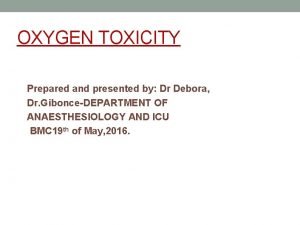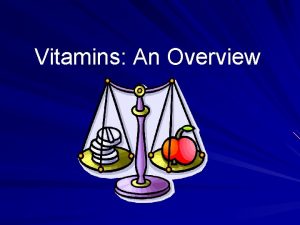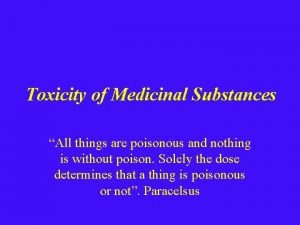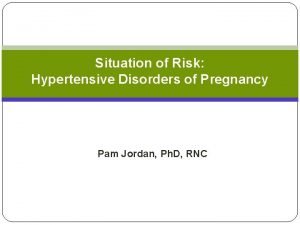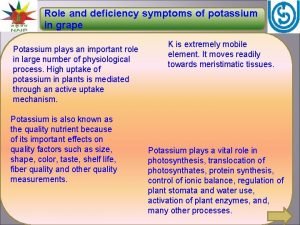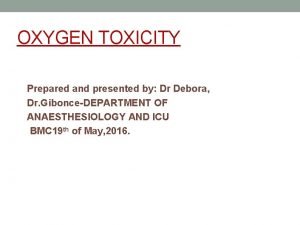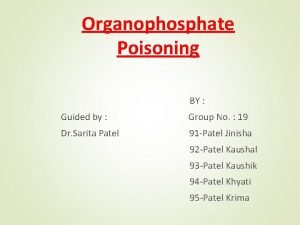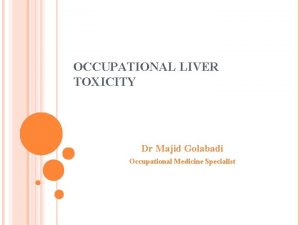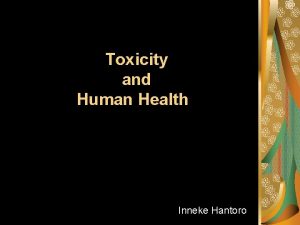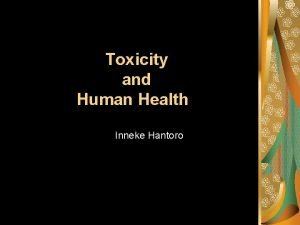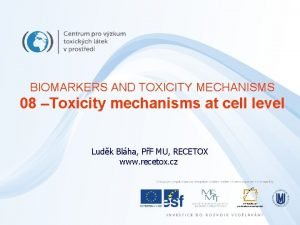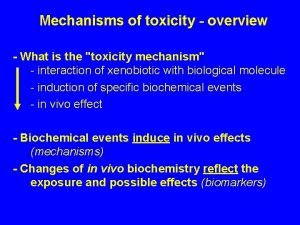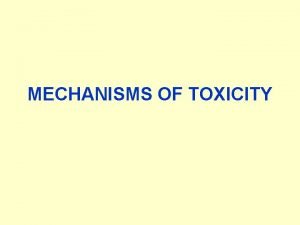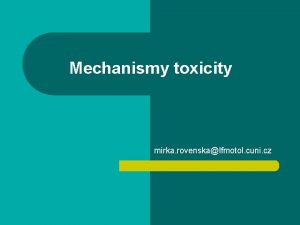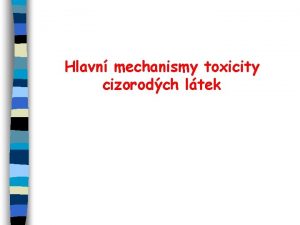Neurological and Psychiatric Toxicity 2 Neurological and Psychiatric









- Slides: 9

한약독성학 Neurological and Psychiatric Toxicity 박사 2기 김범정

Neurological and Psychiatric Toxicity. Direct toxicity by herbal : cerebral arteritis (뇌동맥염), coma (혼수), confusion ( 착란), hallucinations (환각), stroke (뇌졸중), movement disorders (운동장애), mood disturbances (기분장애), and seizures(간질성발작). Multiple herbs : ginseng, jimson weed (흰독말풀), passionflower (시계초), kava (카바), nutmeg (넛메그, 육두구), and St John’s wort.

Ginseng § plant genus Panax, a wide range of uses. § improving respiratory, GI (당지수), and central nervous system functions, breast, ovarian, liver, lung, and skin cancer. § Being used anemia (빈혈), hyperlipidemia (고지혈), diabetes, impotence (발 기부전), fever, hangover (숙취), rheumatism, convulsions (경련, 경기), menopause-related hot flashes (폐경기 안면홍조), anxiety, depression, chronic fatigue syndrome, loss of appetite, fibromyalgia (섬유근육통), insomnia, and to slow the aging process. Topically, being used to treat premature ejaculation (조루). Being found in energy drinks, soaps, and cosmetics. § Active compounds ; ginsenosides (which are called panaxosides), pectin, B vitamins, flavonoids, and panaxans. Some of the ginsenosides have conflicting activity ; 1 type of ginsenosides may raise blood pressure and be a central nervous system (CNS) stimulant, while another may decrease blood pressure and be a CNS depressant. Ginsenosides also have effects on platelet aggregation and coagulation (응고) and have neuroprotectivity. relaxing bronchial smooth muscle (asthmatics).

§ Panax ginseng : Being used to combat stress (having affected hypothalamic -pituitary-adrenal axis (시상하부-뇌하수체-부신 축) and increasing cortisol levels). Being used in cancer (due to decreased production of tumor necrosis factor, diminished DNA strand breakage, and decreased proliferation of cancer cells and inhibition of formation of induced skin tumors). Being lower cholesterol and triglycerides (to increases in lipoprotein lipase activity, enhance lipid metabolism). To aid diabetic patients (panaxans having hypoglycemic effects, decreasing tissue insulin resistance and directly stimulate insulin release). The active compounds contained in Panax ginseng come from the root. § In the 1970 s and 1980 s there was discussion of a possible ginseng abuse syndrome associated with long use and higher doses of ginseng. Shortterm use ; diarrhea, anxiety, insomnia, nonspecific dermatitis (피부염), depression, mania (조증), decreased appetite, amenorrhea (월경불순), and hypertension. Patients with psychiatric conditions may be more susceptible to the psychiatric adverse. § Usual doses of ginseng extract are 100 mg twice daily. Panax ginseng therapy is not recommended for more than 3 months. Higher doses are more likely to cause adverse effects.

Valerian (쥐오줌풀) § the family Valerianaceae (마타리과). § being used for insomnia, anxiety, depression and other mood disorders, epilepsy (뇌전증, 간질), ADHD (주의력결핍 과잉행동장애), and chronic fatigue syndrome. Being used for psychological stress, menstrual cramps ( 생리통), and symptoms associated with menopause (폐경기). The active parts of valerian include the rhizome and the root. § The active compounds : valepotriates, baldrinals, volatile oils, monoterpens, flavonoids, and sesquiterpenes. Can vary greatly from root to rhizome and also with the different species of valerian. having sedative-hypnotic (진정최면. agonist effects on GABA), anxiolytic (불안완화), antidepressant, anticonvulsant (항경련), and antispasmodic (항경련) effects. § Multiple active compounds : Sedative-hypnotic effects (agonist effects on GABA. directly bind to GABA receptors and stimulate the release and reuptake of GABA). Some of the valerian flavonoids also bind to the benzodiazepine-binding sites.

§ Valerian is available in many different forms, including extract and teas. For insomnia the recommended dose is 400 -900 mg valerian extract orally up to 2 hours before bedtime, 300 -450 mg of valerian extract orally in 3 divided doses. It is safe to use for up to 28 days. § Overdose ; Fatigue, chest tightness, abdominal cramping (복부경련), and tremor of hand foot were seen in a patient after 20 times the recommended valerian dose was ingested. Benzodiazepine-like withdrawal has been noted after discontinuation of valerian therapy. Other adverse effects ; headache, excitability, uneasiness, cardiac disturbances (장애), and insomnia. § Adverse effects are more likely seen in patients taking higher doses for prolonged periods. Valerian’s effects on the benzodiazepine receptors may cause a withdrawal syndrome; therefore, abrupt cessation (중단), especially after prolonged therapy, is not recommended. Doses should be tapered gradually, preferably under the care of a physician.

Jimson weed (Datura stamonium) (흰독말풀) § being used to treat asthma, cough, and pertussis (백일해), for diseases of the autonomic nervous system (자율신경계), hallucinations and euphoria (극도의 희열) § The active compounds : belladonna alkaloids, including atropine, Lhyoscyamine, and L-scopolamine. Anticholinergic effects. § Overdose ; acute anticholinergic toxicity and death. Jimson weed has long been smoked (leaves) or ingested orally (seeds) to obtain its hallucinogenic and euphoric effects. § The seeds contain the highest concentration of belladonna alkaloids. An adult lethal dose is 15 -100 g of leaf or 15 -25 g of seeds, which is equivalent to 100 mg atropine. § Adverse effects of ingestion of jimson weed include dilated pupils, tachycardia (심계항진), blurred vision (몽롱), auditory (청각) and visual hallucinations, hyperthermia (고체온증), hypertension, confusion, and seizures (발작). Death in acute toxicity can result from CNS depression, circulatory collapse, and hypotension. Use of jimson weed is not recommended due to possible adverse effects.

Passionflower (Passiflora incarnate) (시계초) § Being used in the treatment of insomnia, anxiety, symptoms of opiate withdrawal (아편금단), neuralgia (신경통), seizures, menopause, ADHD, nervousness (신경과민), fibromyalgia (섬유근육통), and pain relief. Topically, passionflower is used in bath preparations and for hemorrhoids (치질), burns, and inflammation. Passionflower extract is also used for flavoring ( 조미료). § The active compounds : flavonoids (apigenin, luteolin, quercetin, kaempferol, and vitexin), Harman alkaloids (harmine, harmalol, Harman, and harming), maltol, and ethyl maltol. § There is controversy (논란) about whether passionflower contains a cyanogenic glycoside, gynocardine. The flavonoids and alkaloids are responsible for its sedative, hypnotic, anxiolytic, analgesic (진통), and antispasmodic (진경) effects. The active compounds may bind to the benzodiazepine receptors, causing anxiolysis without affecting memory or motor skills. Affects may also be seen on the monoamine oxidase system, although more research is needed to confirm this.

§ Passionflower is available as a liquid extract, tablet, tea, tincture, and crude dried parts. Dosing for anxiety is 45 drops of passionflower extract daily or 90 mg daily. Use for up to 1 month is considered safe. § Adverse effects associated using passionflower include dizziness, confusion, sedation, and ataxia (운동실조증). One case report describes a patient who developed severe nausea (메스꺼움), vomiting, drowsiness (졸림), prolonged QT (심박수) interval, and episodes of nonsustained ventricular tachycardia (비지속성 심실성 항진). This patient reported taking therapeutic doses of passionflower. § Passionflower was approved for use in the USA as an over-the-counter sleep aid and sedative in the 1970 s. Since that time it has been removed from the market for lack of safety and efficacy data.
